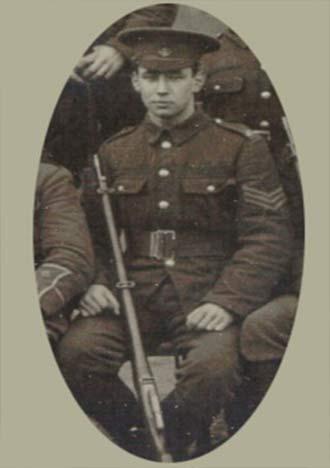
Introduction
1 July 1916 was terrible day for Newfoundland and Labrador. It was the opening day of the Battle of the Somme during the First World War. Near Beaumont-Hamel, France, the Dominion of Newfoundland lost hundreds of soldiers within a few hours. Newfoundland and Labrador still remembers this tragedy even more than a century later.
Early life
Wilfrid was the son of Charles and Diana (Stevenson) Ayre. He was born on 15 July 1895 in St. John’s, the Dominion of Newfoundland’s capital city. The Ayre family owned Ayre and Sons Ltd., a department store in the city. It was a large family and Wilfrid had many cousins. All of them attended the same school in St. John’s and several also furthered their education in England. Wilfrid and some of his cousins then worked for the family business in St. John’s.

A Proclamation published in the Daily News on 22 August 1914 had an impact on young men in Newfoundland and Labrador. (The Rooms Provincial Archives)
Volunteering for service
The Dominion of Newfoundland was automatically at war when Britain declared war on Germany on 4 August 1914. Many Newfoundlanders were initially very enthusiastic and wanted to support the war effort.
Wilfrid was eager to serve and joined the Newfoundland Regiment in September 1914. He was part of the first wave of recruits known as the First Five Hundred. They were mostly single, young men between 19 and 35 years of age. Wilfrid was well-educated and quickly rose through the ranks. In less than a month he was promoted from private to corporal and was then made a sergeant. The first Newfoundland recruits were ready to set sail for Europe in early October 1914.
The blue puttees
Wilfrid and his fellow soldiers left Newfoundland for Europe aboard the S. S. Florizel. The ship departed St. John’s on 4 October 1914. This first group of soldiers were given the nickname the blue puttees. Puttees are strips of cloth wound around soldiers’ lower legs for warmth and protection. Most British forces wore khaki coloured puttees but when war broke out there wasn’t enough khaki cloth in Newfoundland. Blue cloth was instead substituted for the recruits who made up the First Five Hundred.
Wilfrid trained in England and Scotland before being sent to the Western Front. He continued to be promoted and was soon a 2nd lieutenant. For a time he was posted to the British Expeditionary Force Base Depot near the city of Rouen, France.
Opening day of the Battle of the Somme, 1 July 1916
By June 1916, Wilfrid was in the trenches of northern France. There hadn’t been much movement along the Western Front in 1916. The opposing armies had clashed many times since the start of the First World War with no significant gains for either side after the opening months of the conflict. Front line trenches stretched almost 1,000 kilometres across Belgium and France, from the North Sea to the border of Switzerland.
Allied forces planned a big push to try to break through German defenses along the Somme river in France. The combined French and British assault was launched early on 1 July 1916. That morning, thousands of Allied soldiers jumped out of their trenches and rushed across No Man’s Land. They were met with fierce resistance all along the front lines.
Wilfrid and the soldiers of the Newfoundland Regiment were part of the third wave of the attack near the village of Beaumont-Hamel. The element of surprise had completely vanished by the time they left their trenches at around 9:15 a.m. They followed their orders, though, and marched forward past the bodies of many fallen British soldiers. The enemy fire was constant and deadly.
The Allies were stunned by their losses on the first day of the Battle of the Somme. The German machine guns and artillery took a terrible toll when the action finally stopped a few hours later. More than 57,000 members of the British forces became casualties on 1 July 1916. The Newfoundland Regiment was devastated. In less than 30 minutes, 86% of the men who went over the top were dead, wounded or missing—including 2nd Lieutenant Wilfrid Douglas Ayre and his cousins Gerald, Eric and Bernard.

The four Ayre cousins who died on 1 July 1916.
Burial
Wilfrid was buried at the Knightsbridge Cemetery about a kilometre south of the trenches of Beaumont-Hamel. The horrible losses suffered by the Ayre family that day were symbolic of the grief that would be felt in many families across Newfoundland. The loss of so many of the dominion’s young men on 1 July 1916 left a hole that was felt for decades. Even today, more than a century later, July 1 is still solemnly marked in Newfoundland and Labrador each year as Memorial Day to remember the sacrifices of its service members in the cause of peace.

The Knightsbridge Cemetery, where Wilfrid Ayre is buried.
Photo: Commonwealth War Graves Commission